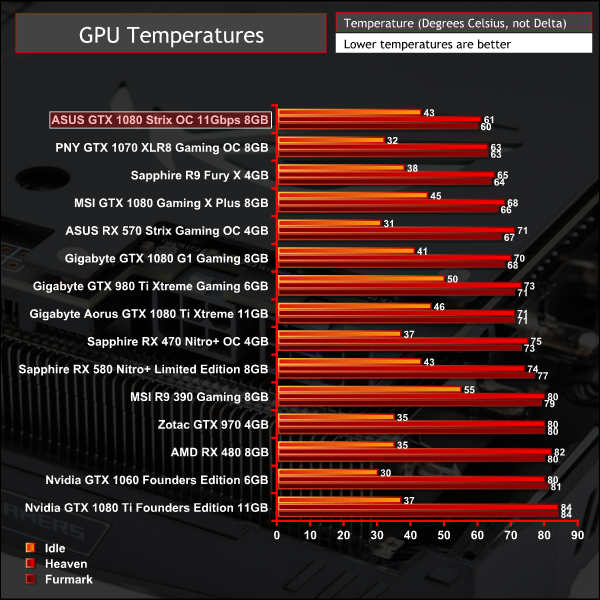Temperatures were measured after 5 minutes of load under three scenario: Furmark, Unigine Heaven and desktop idle in sequential order with 2 minutes of downtime in between each test. GPU-Z was used to record the maximum temperature, fan profiles on GPUs were left to their default behaviour.
Delta temperatures are presented below to account for small fluctuations in room temperature, but for all the testing present in this graph the temperature ranged from 21.6 to 23.1 degrees Celsius.



GPU core temperatures were stupendously good and given that the ASUS card is slightly louder than its rivals it would make sense for ASUS to slacken off the default fan profile in favour of lower noise.
PCB temperatures were acceptable but the exposed VRM components reached into the mid-70s during our stress testing.
ASUS possibly left these exposed as ambient case airflow is better at removing heat than a backplate, however, we've seen lower temperatures on graphics cards with full cover backplates. That said, temperatures in the 70s are perfectly reasonable and are no cause for long-term concern.
 KitGuru KitGuru.net – Tech News | Hardware News | Hardware Reviews | IOS | Mobile | Gaming | Graphics Cards
KitGuru KitGuru.net – Tech News | Hardware News | Hardware Reviews | IOS | Mobile | Gaming | Graphics Cards





That’s a pretty heavy Asus tax when the MSI GTX1080 Gaming X Plus 11gbps is currently available for £460 (£503+£43 msi cashback) if you shop around.
I picked up the MSI GTX1080 Gaming X plus (shorten the names ffs lol) over the Asus because I have a morbid fear of small triple fans after living with a Vapor-X for 3 years, it’s good to see they have the acoustics in check. After a lot of research I still think the MSI is the quieter of the two even if it drops a degree or two which I can live with.